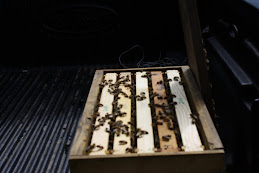It was 70 degrees today so Casey and I decided to give the hive a quick check. The frame in the picture is from the center of the lower box. It show about 50% of the frame is capped honey and the rest has honey in each cell but is uncapped. They are all worker bees and they appear to be very young. Casey thinks that a new brood must have hatched recently. I agree. We are still feeding the bees sugar water because they are drinking it faster than we can put it out.
I talked with the woman at Wills Ridge Lumber about using the back northwest cornor of thier field, which is adjacent to our land, for two hives. She said that I would have to talk with Joe on Friday but that he probably would have no problem with it.
Wednesday, November 14, 2007
Sunday, November 4, 2007
Just Me
Casey took this last week. The bees have kicked out/killed all of the drones and are busily getting ready for winter.
Fall Treatment
We added the 65% formic acid pads on October 28th. The pad is to remain on for three weeks. This is a preventative treatment for both Varroa and Tracheal mites since we have not observed the presence of any mites so far. The problem is that the weather has turned cold and the average daytime temperatures are around 45 to 50 degrees. Hopefully it is not too cold for the treatment to work.
Sunday, October 28, 2007
Checking For Honey
Last week, around October 21, I checked the upper chamber. The picture shows a frame that has a lot of capped and uncapped honey. We have been feeding the bees sugar syrup daily for the past three weeks. Now that the weather has turned a bit colder, we can start the mite treatment with Mite-Away II. I will apply this tomorrow.
Graham and Casey
This picture was taken on the very first day of beekeeping. Graham had just come out and loaded the hive with bees and a queen. There is absolutely no way to express how great it has been to have someone like Graham help us with this adventure. Not only is his knowledge unparalled but his love and passion for honey bees is evident in everything that he does.
Monday, September 24, 2007
The Bees Are Working Hard!
For the past few weeks, as we view the hive, we've noticed that the bees are really active between the hours of 2:00 PM and 4:00 pm. They are flying in and out of the hive so much that it appears as if a cloud is moving around the hive. Casey and I will try to get some photos but it's hard to capture flying bees on film.
Saturday, July 21, 2007
Identifying The Queen
The queens wings are not as long as the other bees,but her body is very long and thin, she has no hair and is very shiny, she is easy to find with a trained eye.
If you can locate her, just behind her, in a cell, is what appears to be a small white thread. This is actually a freshly laid egg!
If you can locate her, just behind her, in a cell, is what appears to be a small white thread. This is actually a freshly laid egg!
Establishing the Hive
We most probably will not get any honey, to harvest, this first year. The bees will spend the time, from now until December, storing enough honey in order to survive the winter. We checked the hive and noticed larvae in the lower brood box. This is good news. We have a second hive consisting of a brood chamber and a super waiting in the wings for the Spring. At that point, we will decide whether to split the hive or order a new Queen and 3 more pounds of bees.
Friday, July 20, 2007
Intent
This blog is intended to document, with pictures, videos, and text, the successes and failures of our beekeeping experience. We started the hive in April with one Queen and 3 pounds of bees (approximately 10,000).
Here's what's happened so far: April through May the bees were doing great. They filled the lower brood box with lots of pollen, wax, and larvae. During the last part of June, they swarmed and we lost the Queen and about half of the colony. We then began checking the brood chamber more often and destroyed about 5 Queen cells while noticing approximately 10 Queen cells that were opened and vacant.
Three days ago, July 17th, we observed the new Queen in the brood chamber and she appeared fat and happy. So we added a second deep and a super. The activity of the bees over the past few days has increased and we're hoping that's an indication of a honey flow.
Here's what's happened so far: April through May the bees were doing great. They filled the lower brood box with lots of pollen, wax, and larvae. During the last part of June, they swarmed and we lost the Queen and about half of the colony. We then began checking the brood chamber more often and destroyed about 5 Queen cells while noticing approximately 10 Queen cells that were opened and vacant.
Three days ago, July 17th, we observed the new Queen in the brood chamber and she appeared fat and happy. So we added a second deep and a super. The activity of the bees over the past few days has increased and we're hoping that's an indication of a honey flow.
Subscribe to:
Comments (Atom)














